 W
WAnselm Adornes, also known as Anselm Adorno, was a merchant, patron, politician and diplomat, who belonged to the fifth generation of the Adornes family to live in Bruges.
 W
WAlbert IV of Austria was a Duke of Austria.
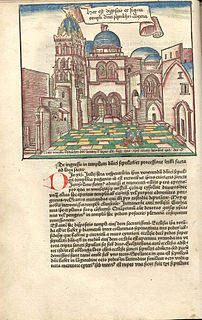 W
WBernhard von Breidenbach was a politician in the Electorate of Mainz. He wrote a travel report, Peregrinatio in terram sanctam (1486), from his travels to the Holy Land.
 W
WAdrian von Bubenberg was a Bernese knight, military commander and mayor (Schultheiss) of Bern in 1468-1469, 1473-1474 and 1477-1479. In Switzerland, he is remembered as the hero of the Battle of Murten.
 W
WNompar of Caumont (1391–1446) was a Gascon lord who left written accounts of his pilgrimages to Santiago de Compostela and Jerusalem. His work has also contributed lexicographic inputs to the Dictionary of Middle French.
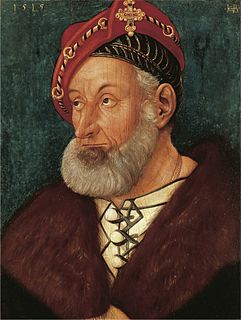 W
WChristopher I of Baden was the Margrave of Baden from 1475 to 1515.
 W
WSir Richard Clough, known by his Welsh contemporaries as Rhisiart Clwch, was a merchant from Denbigh, north-east Wales, and an agent of Queen Elizabeth I of England.
 W
WAndrea Doria was a Genoese statesman, condottiero and admiral, playing a key role in the Republic of Genoa during his lifetime.
 W
WEberhard I of Württemberg. From 1459 to 1495 he was Count Eberhard V, and from July 1495 he was the first Duke of Württemberg. He is also known as Eberhard im Bart.
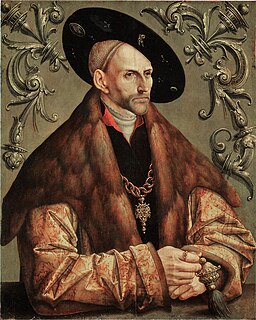 W
WEdzard I, also Edzard the Great was count of East Frisia from 1491 till his death in 1528.
 W
WJohn III of Egmont was first Count of Egmont, Lord of Baer, Lathum, Hoogwoude, Aarstwoude, Purmerend, Purmerland and Ilpendam, and Stadtholder of Holland, Zeeland and West-Friesland.
 W
WEric of Pomerania was the ruler of the Kalmar Union from 1396 until 1439, succeeding his grandaunt, Queen Margaret I. He is numbered Eric III as King of Norway (1389–1442), Eric VII as King of Denmark (1396–1439) and Eric XIII as King of Sweden. Later, in all three countries he became more commonly known as Erik av Pommern, a pejorative intended to point out that he belonged elsewhere. Pomerania is a historic region on the southern shore of the Baltic Sea in Central Europe. Eric was ultimately deposed from all three kingdoms of the union, but in 1449 he inherited one of the partitions of the Duchy of Pomerania and ruled it as duke until his death.
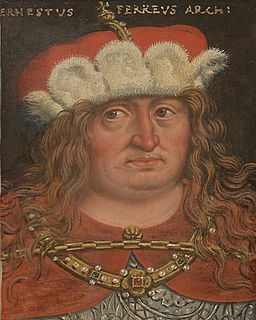 W
WErnest the Iron, a member of the House of Habsburg, ruled over the Inner Austrian duchies of Styria, Carinthia and Carniola from 1406 until his death. He was head of the Habsburg Leopoldian line from 1411.
 W
WFelix Fabri was a Swiss Dominican theologian. He left vivid and detailed descriptions of his pilgrimages to Palestine and also in 1489 authored a book on the history of Swabia, entitled Historia Suevorum.
 W
WFrederick II, Duke of Legnica, also known as the Great of Legnica, was a Duke of Legnica from 1488, of Brzeg from 1521. The most notorious of all Legnica Piast rulers, thanks to his excellent financial politics his Duchy was expanded to the Oder River, and he became the founder of the Duchy of Legnica-Wołów-Brzeg.
 W
WFrederick III, also known as Frederick the Wise, was Elector of Saxony from 1486 to 1525, who is mostly remembered for the worldly protection of his subject Martin Luther.
 W
WFrederick III was Holy Roman Emperor from 1452 until his death. He was the first emperor of the House of Habsburg, and the fourth member of the House of Habsburg to be elected King of Germany after Rudolf I of Germany, Albert I in the 13th century and his predecessor Albert II of Germany. He was the penultimate emperor to be crowned by the Pope, and the last to be crowned in Rome.
 W
WConrad Grünenberg, also spelled Konrad, Grünemberg, Grünberg was a patrician from Constance in southern Germany, known as the author of three books, two armorials and a travelogue: the Österreichische Wappenchronik ; the Wappenbuch, containing some 2000 coats-of-arms, which he presented as a gift to Emperor Frederick III; and the illustrated description of his 1486 pilgrimage to Jerusalem.
 W
WPedro Fernández de Híjar (1245/49-1299) was the first Baron of Híjar, and knight of Order of the Holy Sepulchre. He was the illegitimate son of King James I of Aragon, and Berenguela Fernández. Casaus Ballester (2008), p. 2, documento word
 W
WHugo von Montfort was an Austrian minstrel of the Late Middle Ages.
 W
WAntoine II of Lalaing (1533–1568), 3rd count of Hoogstraten, was a patron and nobleman of the Southern Netherlands. He was the son of the second count Philip de Lalaing and his wife Anna of Rennenberg.
 W
WLouis VII, called the Bearded was the Duke of Bavaria-Ingolstadt from 1413 until 1443. He was a son of Duke Stephen III and Taddea Visconti.
 W
WCarlo Maggi was a Venetian citizen and traveller. During 1568–1573, he visited much of the Near East, then under Ottoman control, including the city of Jerusalem, where he was made a Knight of the Order of the Holy Sepulchre. He was captured by the Turks during the siege of the city of Nicosia in the Cyprus War of 1570-1571, being able to free himself and to get back to Venice only after the Battle of Lepanto in 1572.
 W
WOswald von Wolkenstein was a poet, composer and diplomat. In his diplomatic capacity, he traveled through much of Europe to as far as Georgia.
 W
WOtto I was the Count Palatine of Mosbach from 1410 until 1448, and the Count Palatine of Mosbach-Neumarkt from 1448 until 1461.
 W
WPhilipp I, Count of Hanau-Lichtenberg was Count of Hanau. The county was divided between him and his nephew, Count Philipp I "the Younger". Philipp the Elder's part of the county was later called Hanau-Lichtenberg; Philipp the Younger's part is known as Hanau-Münzenberg.
 W
WHeinrich Reuß von Plauen was the 32nd Grand Master of the Teutonic Order, serving from 1467 to 1470. He was the nephew of the previous Grand Master, Ludwig von Erlichshausen, and a distant relative to the 27th Grand Master, Heinrich von Plauen.
 W
WJan Amor Tarnowski was a Polish nobleman, knight, military commander, military theoretician, and statesman of the Crown of the Kingdom of Poland. He was Grand Crown Hetman from 1527, and was the founder of the city of Tarnopol, where he built the Ternopil Castle and the Ternopil Pond.
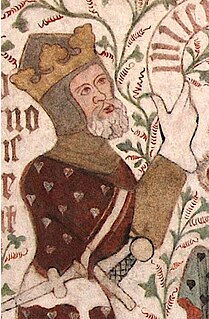 W
WValdemar IV Atterdag, or Waldemar (1320 – 24 October 1375 was king of Denmark from 1340 to 1375. He is mostly known for his reunion of Denmark after the bankruptcy and mortgaging of the country to finance wars under previous rulers.
 W
WWilliam I of Hesse was the Landgrave of Hesse from 1471 to 1493.
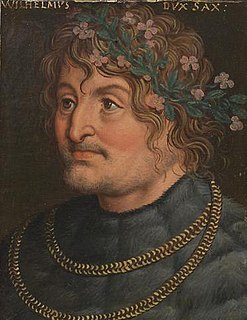 W
WWilliam III, called the Brave, was landgrave of Thuringia and claimant duke of Luxemburg. He is actually the second William to rule Thuringia, and in Luxembourg; he was the third Margrave of Meissen named William.